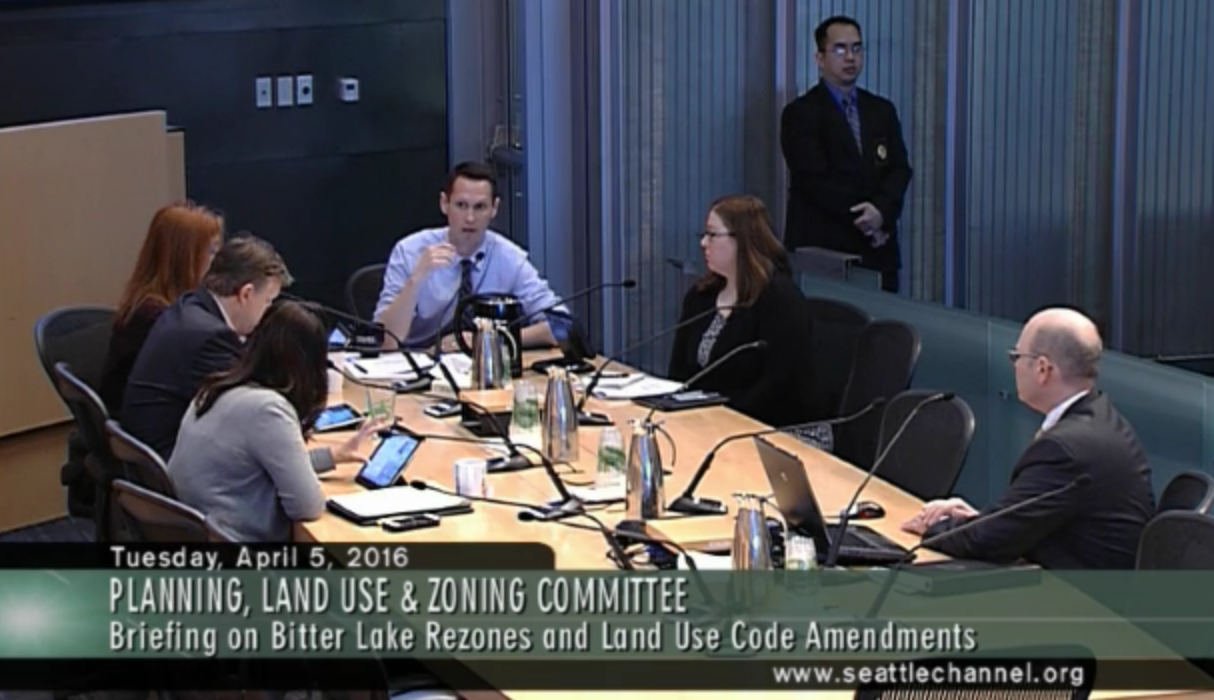At a meeting of the Planning, Land Use, and Zoning (PLUZ) Committee on Tuesday, Councilmembers were briefed by City staff on a density-neutral rezone proposal in the Bitter Lake urban village and recommendations to revise the design review process.
Bitter Lake
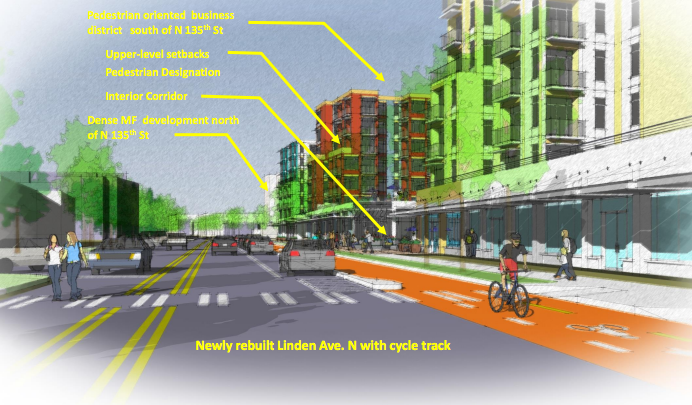
The Office of Planning and Community Development (OPCD) is considering a spate of rezones throughout the Bitter Lake neighborhood and development regulation changes. The proposal is the result of a five-year process with the neighborhood to identify ways to enhance the urban experience of the urban village and to provide local amenities. Staff have identified two key revisions to development regulations within the Bitter Lake urban village:
- Any development that is greater than eight acres would be required to establish a private mid-block crossing between Aurora Avenue and Linden Avenue so as to allow for access by pedestrians, deliveries, and automobiles.
- A 10-foot stepback would be required for any facade above 45 feet when facing Linden Avenue and an interior corridor to provide for pedestrian-scale development.
The proposal would rezone select properties in the northern portion of the urban village from Commercial 2-65 to Commercial 1-65 to allow street level residential and transition those areas to dense, walkable areas. In the southern portion, select properties could receive the Pedestrian zone designation and/or Neighborhood Commercial (NC) zoning designation to encourage mixed-use. In one limited circumstance, two parcels of land could be rezoned from C1-65 to C2-65 in order to allow more commercial uses instead of residential since it has substandard pedestrian connectivity.
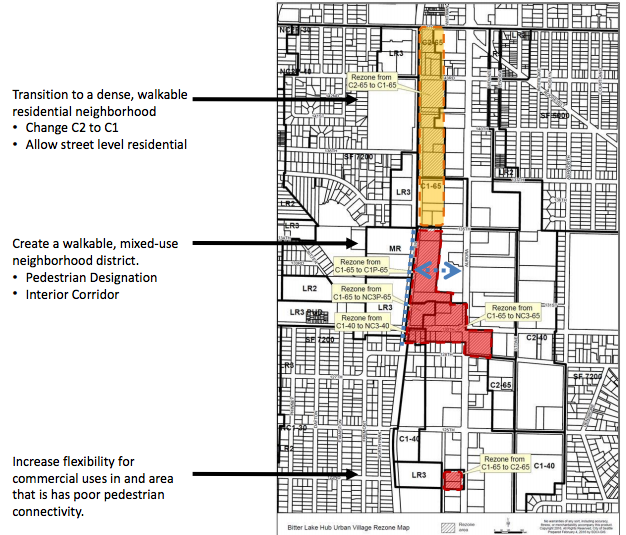
The Pedestrian zone designation is an important aspect to the proposal because it would be established along Linden Avenue from N 135th St to N 130th St. The Pedestrian zone goes beyond the development regulations of what a base zoning like a Commercial or Neighborhood Commercial zone; it requires that new development achieve street level, pedestrian-oriented business along building frontages facing the Pedestrian zone street. It also establishes requirements like minimum density and restricts parking.
To give a taste of what these regulatory changes mean, OPCD provided an overview of how they work:
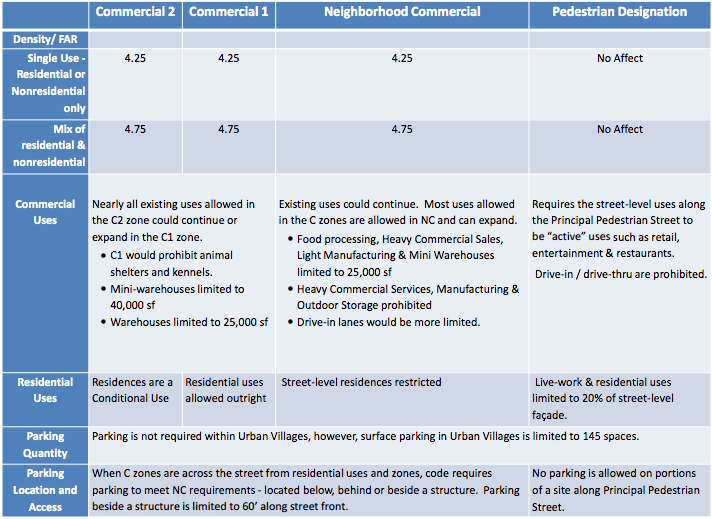
These proposed zoning changes would not result in any actual upzone of the urban village in terms of height and development density, but it could have dramatic impact on the future form of the neighborhood. OPCD staff will eventually submit final legislation to PLUZ later this year.
Design Review Program Improvements
The Seattle Department of Construction and Inspections (SDCI) presented their recommendations for changes to the City’s Design Review Program. Their proposal stems from a desire to vastly improve the program, which was established more than 20 years ago, so that it meets the modern needs of the public and applicants. SDCI has targeted five general areas for improvement, including:
- Early and ongoing engagement;
- Establishing thresholds for the type of design review required based upon the characteristic of sites;
- Using new tools and techniques;
- Amending the structure of design review boards; and
- Revising thresholds for design review.
The first recommendation by SDCI is to encourage early and ongoing engagement. Planners envision applicants conducting public outreach before they submit a formal development application and before a project ever came before design review. The goal of this is to create a community dialogue between the applicant and members of the public. Ideally, this would lead to many issues being sussed out before getting too far along in the process (think Pike Pine Urban Neighborhood Council). This could come in different formats like social media, neighborhood meeting, or even at a local coffeeshop.
The second recommendation is to set thresholds for design review based upon site characteristics and to do more administrative design review. The table below gives an idea about how SDCI staff want to revise the threshold for design review type.
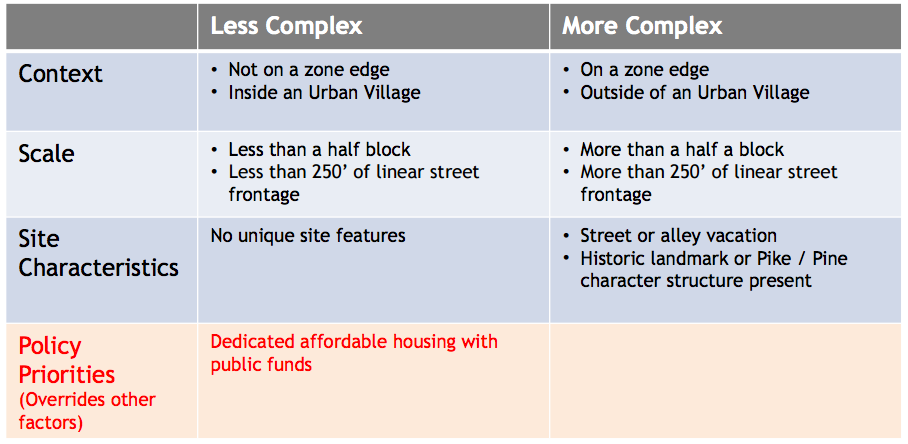
Under the design review program of today, there are three types of design review: full design review, administrative design review, and streamlined design review. The full design review process involved Early Design Guidance and Recommendation by a volunteer board while the administrative design review and streamlined design review are both administrative processes that are shorter and smaller in scale. SDCI recommends that full design review be retained for the largest and most complex projects. A new hybrid design review model could be adopted for smaller, less complex projects. Essentially, that design review would be one review by a volunteer board and then one review by administrative staff. The main reason for this is to reduce delay in the review process for small projects while clearing the deck for larger and more complex projects at the boards. Finally, streamlined and administrative design review would be consolidated under one umbrella as administrative design review with Early Design Guidance and Recommendation by administrative staff.
The third recommendation by SDCI is to use new tools and techniques in design review. Some of the things that staff are proposing, include: using online apps and ability to comment on projects via the web, livestream of meetings, allow two-way dialogue between the public and applicants, add notetakers at public meetings, and commission an awards program to recognize high quality design. Some of these services have been rolled out by SDCI in the past year in some form, like the online web app for mapping project proposals and submitting online comments.
The fourth recommendation by SDCI is to revise the composition of boards throughout the city As it stands today, there are seven design review boards by geographic area with five design review board members assigned to each. SDCI would consolidate these into five boards. Interestingly, the new Central Design Review Board would be responsible for some of the densest and most development active areas of the city. Staff suggested that this would allow that board to specialize in very complex reviews like highrise and skyscraper development. Meanwhile, the other design review boards would be able to focus on primarily lowrise development and local issues. The composition of each board would grow by two members for a total of seven in order to add additional expertise like landscape architect and ensure that boards more regularly have a quorum.
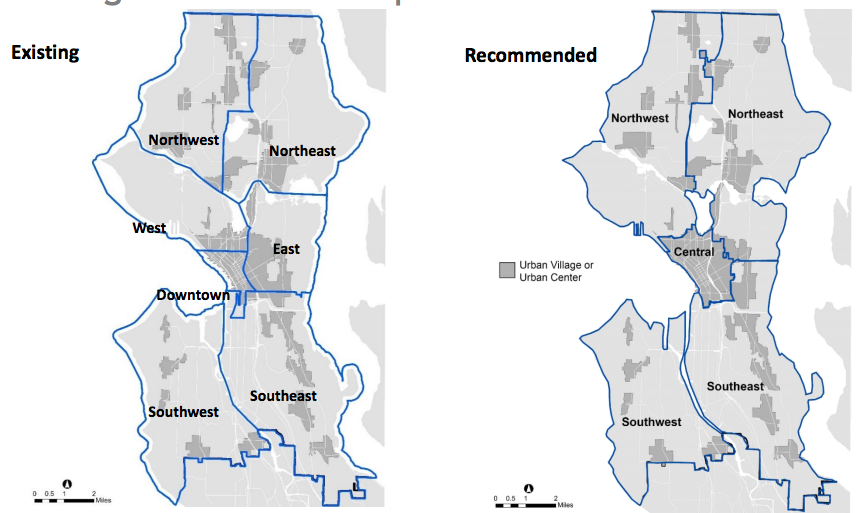
The fifth recommendation that SDCI is considering involves substantial changes to the thresholds for when design review is required. Current code generally establishes design review based upon zone and the proposed number of units or gross square feet for commercial. The recommended changes would establish thresholds based upon total gross square footage and site characteristics.
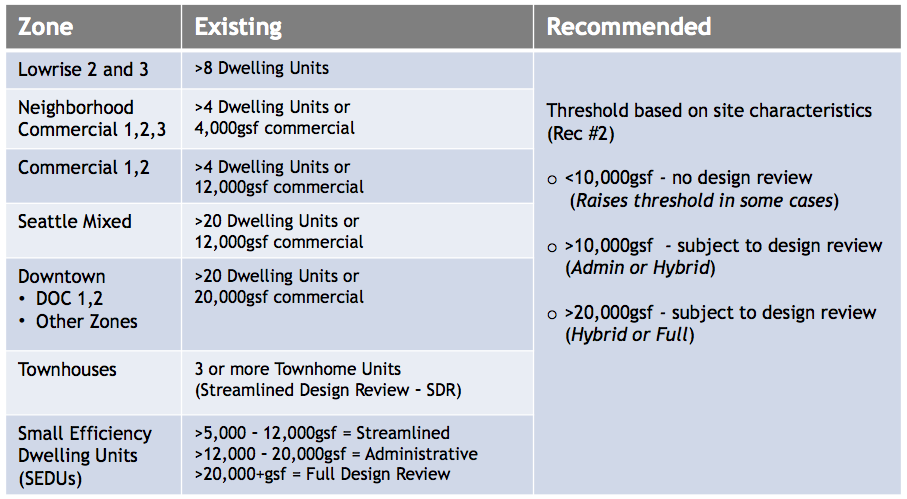
At the conclusion of the presentation, Councilmember Rob Johnson thanked staff for their work on the recommendations, but proposed that SDCI hold on forwarding legislation until Council had completed work on the Seattle 2035 comprehensive plan update, rezones, and much of the HALA process. Other members of the committee chimed in to voice their support for some elements of the SDCI recommendation and said that they wanted to fast-track aspects of the proposal like public engagement for piloting. They agreed to make some movement on the recommendations in future meetings of the committee.
Stephen is a professional urban planner in Puget Sound with a passion for sustainable, livable, and diverse cities. He is especially interested in how policies, regulations, and programs can promote positive outcomes for communities. With stints in great cities like Bellingham and Cork, Stephen currently lives in Seattle. He primarily covers land use and transportation issues and has been with The Urbanist since 2014.


